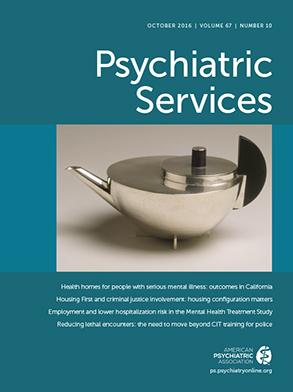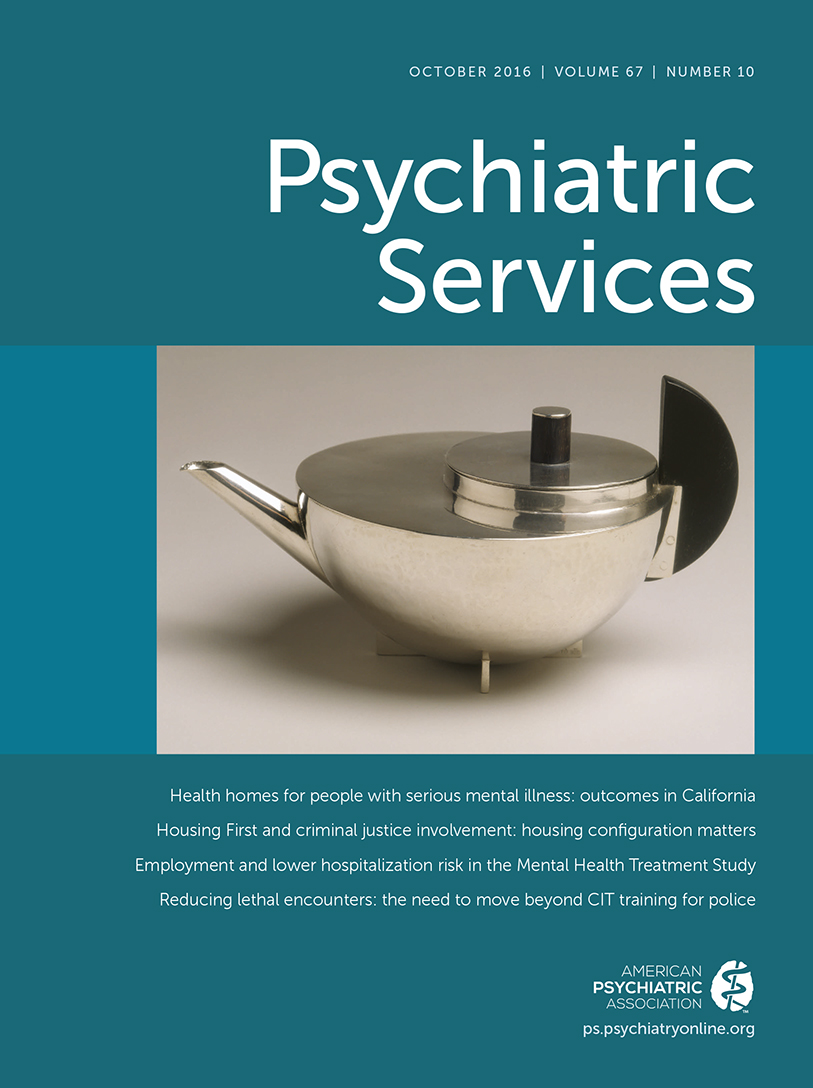To alleviate the overrepresentation of people with psychiatric and substance use disorders in the criminal justice system, programs have been established to divert people with these conditions from traditional justice system processing and into treatment (via drug and mental health courts). Although clinical guidelines may differ depending on whether one condition is primary, one fundamental treatment principle for debilitating co-occurring disorders is to provide concurrent mental health and substance abuse treatment (
1). However, only about half of those with co-occurring disorders receive either mental health or substance abuse treatment, and the utilization of concurrent mental health and substance abuse treatment is reportedly even lower (
2,
3). For adults with mental illnesses or substance use disorders who have been involved in the justice system, the literature has shown mixed findings on the relationship between justice involvement and utilization of mental health and substance abuse treatment services, with some studies suggesting that the criminal justice system may facilitate access to treatment (
4–
6) and others concluding that a criminal record may create a barrier to treatment (
7–
9). Moreover, it is unknown how criminal justice involvement may be related to utilization of concurrent mental health and substance abuse treatment services among adults with co-occurring disorders.
Using five years of data from the National Survey on Drug Use and Health (NSDUH), we examined how a history of criminal justice involvement may be related to use of mental health services, substance abuse treatment services, and both services within the past year among adults with a past-year mental health and substance use problem. Given the recent growth in incarceration alternatives, it was expected that justice involvement would be positively associated with utilization of treatment.
Methods
Data were obtained from the NSDUH, a nationally representative data set. We pooled five years of data (2009–2013), then selected individuals age 18 or older who self-reported having both a mental illness and substance abuse or dependence (N=8,740, 3.1% of total survey sample). Probable mental illness was identified with the method developed by the NSDUH. On the basis of participants’ responses to items assessing level of psychological distress and functional impairment in the past year, the NSDUH methodology considers respondents to have mild mental illness if the probability is greater than .019 and severe mental illness if the probability is greater than .26 (
10). The cutoff point of .019 was used to select the sample. Previous studies have shown this to be a reliable method of identifying people with mental illness (
11). The presence of substance abuse or dependence was based on the respondents’ reports on drug (excluding tobacco) and alcohol abuse and dependence criteria as specified in
DSM-IV.
Use of mental health treatment was determined if respondents reported that they had received mental health treatment or counseling for any problem with emotions, nerves, or mental health in the past year at a hospital or clinic. Substance abuse treatment was determined if respondents reported having received treatment or counseling for their substance use in the past year at a hospital as either an inpatient or outpatient, in prison or jail, in a self-help group, or in some other setting. Responses were coded as utilization of both mental health and substance abuse treatment in the past year, utilization of mental health treatment alone, utilization of substance abuse treatment alone, or no treatment utilization (reference group).
A criminal history was indicated if there was any affirmative response to items assessing “ever arrested and booked for breaking the law in the past year,” “on parole or supervised release status in the past year,” or “on probation status in the past year.”
Covariate selection was informed by the Andersen behavioral model of health service utilization (
12). Specifically, sex (0, male; 1, female), race-ethnicity (non-Latino white [reference], non-Latino black, and Latino), and the midpoints of NSDUH-provided age ranges were included as predisposing variables. Insurance status was included as an enabling variable (0, no insurance; 1, private or public insurance). Severity of mental illness (0, mild to moderate mental illness; 1, severe mental illness), severity of substance use (0, substance abuse; 1, substance dependence), and a self-evaluation of overall health condition (1, poor; 2, fair; 3, good; 4, very good; and 5, excellent) were included as indicators of need for treatment.
Analyses were conducted with the survey procedures of SAS version 9.3 to account for sampling weights. Rao-Scott chi-square tests (
13) were conducted to compare service utilization patterns and the distribution of covariates within the sample. Multinomial logistic regression, controlling for the predisposing, need, and enabling factors described above, was used to examine treatment patterns.
Results
Unadjusted analyses revealed that the pattern of mental health and substance abuse treatment utilization differed significantly between individuals with and without a criminal history. Individuals with a criminal history were more likely to receive both types of treatment or substance abuse treatment alone in the past year than those without a criminal history. [Details on sample characteristics and comparisons between individuals with and without a criminal history are available in the online supplement to this report.]
Table 1 presents the regression results. Consistent with the unadjusted analyses, the final regression showed that individuals with a criminal history were more likely than those without a criminal history to receive concurrent treatment and substance abuse treatment alone, yet there was no difference in the receipt of mental health treatment alone. Results also indicate that predisposing (race-ethnicity, age, and gender), need (severity of mental illness and substance use problems), and enabling (insurance status) factors were related to mental health and substance abuse treatment utilization.
Discussion and Conclusions
The results suggest that criminal justice referrals or mandates are being utilized to effect receipt of contemporaneous substance abuse and mental health treatment among people with co-occurring disorders. A similar effect of criminal history on substance abuse treatment was also observed. This observation may reflect the possibility that, for individuals with a history of criminal justice involvement, substance use disorders are often identified as the primary treatment diagnosis or as contributing to mental health problems. Unfortunately, limitations of the data set did not allow for exploration of how primary and secondary diagnoses may influence the service utilization patterns observed.
For those who experience both debilitating substance use and mental health problems contemporaneously, however, this finding reflects a gap in needed services (
1). Methods for alleviating this observed dependence on substance abuse treatment for this population will need to address the underlying reasons for this overreliance, which may include lack of community- or corrections-based mental health and co-occurring disorders treatment services; agency policies limiting mental health services for people with substance use disorders, criminal histories, or both; the greater prevalence of drug courts than mental health courts, resulting in treating more people with co-occurring disorders and justice involvement through a drug treatment perspective; greater ability of substance abuse treatment providers to serve the uninsured (insurance status was not related to substance abuse treatment in this study, although it was associated with other forms of treatment); and the growing prominence of the risk-needs responsivity model (
14), which prioritizes substance abuse treatment over mental health treatment in offender rehabilitation.
Findings also reveal that compared with whites, black and Latino respondents with co-occurring disorders were significantly less likely to utilize mental health and contemporaneous mental health and substance abuse treatment. These observations reflect findings from previous studies (
15) and highlight the continuing need to reduce racial-ethnic disparities in the utilization of behavioral health services. Results also support the well-established role of need factors (severity of mental health and substance use problems) in service utilization (
12).
Study findings should be interpreted with consideration of the following limitations. First, institutionalized people, such as inpatients and incarcerated people, were excluded from analysis on the basis of the NSDUH sampling scheme; study findings therefore may not fully represent these populations. Second, co-occurrence of mental illness and substance abuse or dependence was not identified with research or clinical diagnoses, so respondents may have been misclassified. However, given that the NSDUH predicted probability method for identifying individuals with mental illness is considered to be comparable to the structured diagnostic interview, minimal bias is expected. Finally, the ability to identify primary diagnoses was lacking, and the use of mental health and substance abuse treatment within the same one-year time frame does not necessarily mean that services received were concurrent or integrated, as is best practice for the treatment of co-occurring disorders. Future research should be conducted on utilization patterns and on barriers and facilitators of concurrent mental health and substance abuse treatment for justice-involved individuals with co-occurring disorders.

